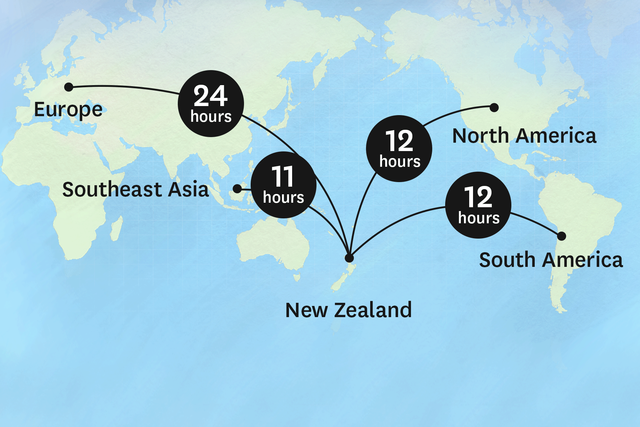Getting here
Air travel to Auckland
Travelling to New Zealand is easy with available flights from many international destinations.
Depending on where you are coming from around the world, there are available flights to New Zealand that fly into Auckland, Christchurch, Wellington, Queenstown or Dunedin. Auckland Airport (AKL) is a major airline hub and is the most common airport for international flights. Visitors can continue to other destinations through domestic flights from Auckland.
Another popular way to get to and explore the country is by Cruise. Most cruises to New Zealand depart from Australia and the Pacific Islands and some are round-the-world journeys.
You can also contact a travel agent if you need help in planning your New Zealand holiday.
Auckland Transport
SkyBus
SkyBus operates every day between 5am – 10pm, including public holidays with 30-minute departures throughout the day to get you on your way quickly. No need to book – just turn up and go!
For more information on SkyBus click here
Public transport – train, bus and ferry
Auckland’s public transport network is a great way to get around. As well as inner-city buses, you can travel by train, ferry, or bus throughout the wider region.
The main transport hub is located downtown, with the ferry terminal, Britomart train station and Link bus departure points all in this area. (Due to construction in the downtown area, some bus departure points have moved further up town). Several bus and train stations and some ferry departure points also have park and ride facilities. Find public transport services, maps, and timetables at AT journey planner.
Taxis
There are a range of taxi companies in Auckland that you can use to travel between the airport and your accommodation.
Below are a selection:
• Auckland Co-op Taxis (09 300 3000)
• Green Cabs (0800 464 7336)
• Discount Taxi (09 529 1000)
• Corporate Cabs (09 377 0773)
Visas and immigration
We enjoy welcoming visitors to New Zealand. To ensure you have an experience to remember, make sure you’ve done your homework and have everything sorted before you leave.
When you arrive, your passport must be valid for at least three months beyond your intended departure date, and if required, have a valid New Zealand visa.
From 1 October 2019, visitors from visa-waiver countries must request an Electronic Travel Authority (ETA) prior to coming to New Zealand. You may also have to pay an International Visitor Conservation and Tourism Levy (IVL). For more information on the ETA and IVL, visit Immigration New Zealand.
Before travelling to New Zealand, you need to make sure your passport is valid for at least three months longer than your expected departure date. If you come from a country that needs a New Zealand visa to enter, please be sure to apply in advance.
Click here for more information: https://www.mpi.govt.nz/bring-send-to-nz/bringing-and-posting-items-to-nz/how-to-declare-items-when-arriving-in-nz/
Bio Security
In order to protect New Zealand and its environment, certain items are not allowed to be brought into the country, have restrictions for entry, or must be declared if they are deemed to present a biosecurity risk. These include food, plants, animal products and outdoor recreational equipment. You may risk a fine if you fail to comply
Click here for more information: https://www.mpi.govt.nz/bring-send-to-nz/bringing-and-posting-items-to-nz/how-to-declare-items-when-arriving-in-nz/
Health requirements
To enter New Zealand, you must meet some health requirements, including:
• You must provide a negative COVID-19 pre-departure test: Get a pre-departure test https://covid19.govt.nz/international-travel/travel-to-new-zealand/pre-departure-tests-to-enter-new-zealand/
• You must meet vaccination requirements: Check vaccination requirements https://covid19.govt.nz/international-travel/travel-to-new-zealand/vaccination-requirements-for-travel-to-new-zealand/
• After you enter New Zealand you must do 2 rapid antigen tests (RATs) on Day 0/1 and Day 5/6 and declare your results. All positive RATs must be registered and followed up with a PCR test. Testing requirements after arriving https://covid19.govt.nz/international-travel/travel-to-new-zealand/testing-requirements-after-arriving-in-new-zealand/
Useful information
Climate
The weather varies throughout New Zealand by region and by season.
https://www.newzealand.com/int/feature/new-zealand-climate-and-weather/
Currency & costs
The currency used is the New Zealand Dollar (NZD).
https://www.newzealand.com/int/feature/new-zealand-currency/
Internet & phone coverage
Staying connected in New Zealand is easy with a little forward planning.
https://www.newzealand.com/int/feature/internet-and-wifi-access-in-new-zealand/
Time Zone
New Zealand is one of the first places in the world to see the new day, 12 hours ahead of GMT (Greenwich Mean Time).
https://www.newzealand.com/int/feature/new-zealand-time-zones/
Electricity
New Zealand’s electricity supply runs at 230/240 volts and uses angled two or three pin plugs (the same as Australia and parts of Asia).
https://www.worldstandards.eu/electricity/plugs-and-sockets/i/
i-SITE New Zealand
i-SITE is New Zealand’s official visitor information network. There are currently 80 i-SITE locations found throughout New Zealand where you can speak to a travel expert for local knowledge and bookings throughout New Zealand.
https://www.newzealand.com/int/visitor-information-centre/
Qualmark
Whether you are looking for places to stay, things to do or ways to get around, Qualmark – New Zealand tourism’s official quality assurance organisation – provides a trusted guide to quality travel experiences. When you see the Qualmark, it means that those businesses have been independently assessed against a set of national quality standards.


